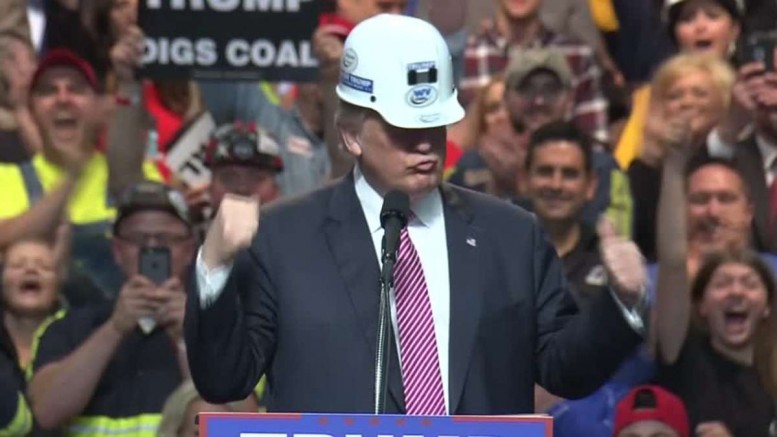Mining’s contribution to the recent U.S. presidential election was nicely captured in the interactions of the two leading candidates with coal miners in the Appalachians.
In March 2016, Democratic Party candidate Hillary Clinton, in touting her support of Democrat-friendly alternative energy industries, memorably told a town hall meeting in the hard-hit coal-mining state of West Virginia that “we’re going to put a lot of coal miners and coal companies out of business.” She later apologized for the comment. (Clinton ended up losing the state to Donald Trump, despite its substantial union presence, garnering only 26% of the vote compared to Trump’s 69%, and well off Barack Obama’s 36% tally in the 2012 presidential election.)
Trump, meanwhile, said he would “bring coal back 100%” and made the Appalachian coal miners part of his stump speech in the northeastern states, saying that “we’re going to get those miners back to work … we’re not going to be Hillary Clinton … talking about the miners as if they were just numbers. Believe me. You’re going to be proud again to be miners.”
Now that Trump has won the election, we can try to separate the campaign bluster and hyperbole from any achievable policy changes that could help the struggling miners of the Appalachians — i.e., the 60,000 miners still left in West Virginia, Kentucky, Ohio, Alabama, Pennsylvania, Maryland, Virginia and Tennessee.
Coal powers a third of U.S. electricity, down from 50% in past decades, but even sharper declines in coal prices in recent years have bankrupted most of America’s biggest coal miners, and left them to scrape along as shells of their former selves.
Pro-coal groups in the U.S. have complained for years of the federal government’s so-called “war on coal,” and much of their ire centres on the Obama administration’s Clean Power Plan, which Republicans have vowed to repeal, and are likely to do so in short order. Other regulations that have raised the cost of coal power plants such as the Mercury and Air Toxics Standard and the Cross-State Air Pollution Rule may also be in the coal sector’s crosshairs.
While Appalachian coal production has declined steadily over the past 25 years, most of it has been replaced by coal production from the prolific Powder River basin (PRB) in Montana and Wyoming, which became economic when rail transportation rates fell. With its exceptionally thick seams, shallow depths and low sulphur content preferred by power generators, today’s PRB coal producers are a formidable competitor to their coal cousins out East, with their smaller, less efficient and more polluting operations.
Indeed, despite all the job losses, shutdowns and bankruptcies plaguing the U.S. coal industry, total U.S. coal production has been relatively constant since at least 1990, moving up and down around 260 million tonnes per annum, as highly efficient PRB operators expand their market share at the expense of Appalachia.
Trump’s campaign stance relating to energy production in the U.S. was a simple promise to eliminate all executive and congressional limits on fossil fuel production on federal lands and waters. In many ways that would benefit the PRB coal miners over the Appalachian producers, as so much land in the U.S. Northwest is deemed federal land.
The emergence over the past 20 years of relatively cheap and clean natural gas-powered electricity in the U.S. has been hard on Appalachian miners. Last year, as the fracking revolution rolled along, natural gas surpassed coal for the first time as the main fuel for electricity generation in the U.S., rising from 15% in 1998 to above 35% today.
Trump’s pledge to lift federal restrictions on federal lands for energy extraction could arguably benefit natural gas production even more than coal mining, further depressing the coal sector’s fortunes.
One Trump pledge that seems likely to be fulfilled and will benefit all miners in the U.S. is a reduction in corporate income taxes to levels more competitive with rival nations. For example, the federal corporate tax rate is 39% in the U.S., compared to 26% in Canada, which lowered its rate from 43% in 2000, resulting in a number of U.S. companies relocating to Canada — such as Burger King in 2014.



I BELIEVE THE TVA SHOULD BE SOLD LIKE CQ WAS SOLD TO PAY FOR SOME OF HIS PROGRAMS. THE STOCK COULD BE OFFERED TO POWER USERS OF TVA FIRST.